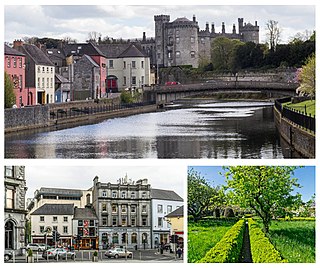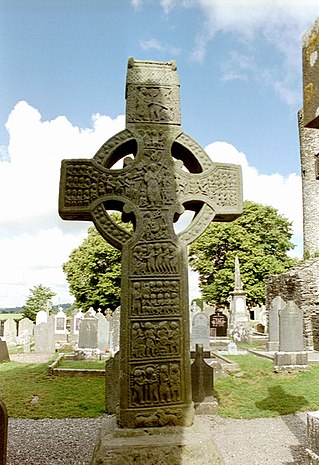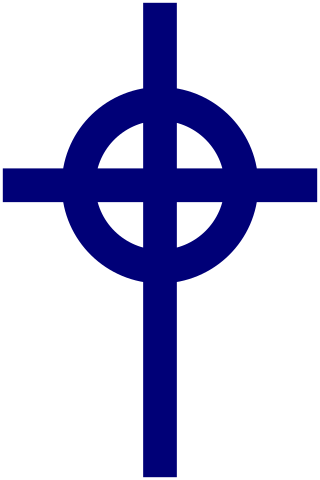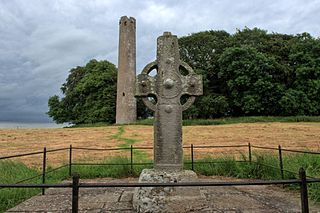
Kilkenny is a city in County Kilkenny, Ireland. It is located in the South-East Region and in the province of Leinster. It is built on both banks of the River Nore. The 2022 census gave the population of Kilkenny as 27,184.

A high cross or standing cross is a free-standing Christian cross made of stone and often richly decorated. There was a unique Early Medieval tradition in Ireland and Britain of raising large sculpted stone crosses, usually outdoors. These probably developed from earlier traditions using wood, perhaps with metalwork attachments, and earlier pagan Celtic memorial stones; the Pictish stones of Scotland may also have influenced the form. The earliest surviving examples seem to come from the territory of the Anglo-Saxon kingdom of Northumbria, which had been converted to Christianity by Irish missionaries; it remains unclear whether the form first developed in Ireland or Britain.

The Celtic cross is a form of Christian cross featuring a nimbus or ring that emerged in Ireland, France and Great Britain in the Early Middle Ages. A type of ringed cross, it became widespread through its use in the stone high crosses erected across the islands, especially in regions evangelized by Irish missionaries, from the ninth through the 12th centuries.

The Ruthwell Cross is a stone Anglo-Saxon cross probably dating from the 8th century, when the village of Ruthwell, now in Scotland, was part of the Anglo-Saxon Kingdom of Northumbria.

Dragons, or worms, are present in Germanic mythology and wider folklore, where they are often portrayed as large venomous serpents. Especially in later tales, however, they share many common features with other dragons in European mythology.

Killamery is a village in County Kilkenny, Ireland. It was the site of a famous monastery under the abbacy of St. Gobban, who died 639 and was buried in the hallowed grounds of St.Fintan of Clonenagh's Abbey, County Laois.

Christ treading on the beasts is a subject found in Late Antique and Early Medieval art, though it is never common. It is a variant of the "Christ in Triumph" subject of the resurrected Christ, and shows a standing Christ with his feet on animals, often holding a cross-staff which may have a spear-head at the bottom of its shaft, or a staff or spear with a cross-motif on a pennon. Some art historians argue that the subject exists in an even rarer pacific form as "Christ recognised by the beasts".

Saint Gobhan has long been linked with the parish of Seagoe – recorded for instance as Teach dho-Ghobha – in County Armagh, Ireland.

Ullard Church is a medieval church and National Monument in County Kilkenny, Ireland.

Maudlin Castle is a tower house which formed part of a medieval hospital and National Monument located in Kilkenny, Ireland.
Clonamery Church is a medieval church and National Monument in County Kilkenny, Ireland.

Kilkieran High Crosses are a group of high crosses which form a National Monument in County Kilkenny, Ireland.

Kilree is a former Christian monastery and National Monument located in County Kilkenny, Ireland.
Brian Boru's Fort, also called Béal Ború, is a ringfort and National Monument located in County Clare, Ireland.

The Arraglen Ogham Stone is an ogham stone and a National Monument located in County Kerry, Ireland.

Inchagoill is an island in Lough Corrib, Ireland. Its Christian ruins constitute an Irish National Monument. The island name means "Island of the devout foreigner."
Maumanorig or Kilcolman is the site of the remains of a medieval Christian monastery and National Monument located on the Dingle Peninsula, County Kerry, Ireland.
Reenconnell is a medieval Christian site and National Monument located on the Dingle Peninsula, County Kerry, Republic of Ireland.
The Emlagh East Ogham Stone, also called the Priest's Stone is an ogham stone and a National Monument located in County Kerry, Ireland.

Felix Ua Duib Sláin, often anglicised as Felix O'Dullany was a medieval Irish bishop.
















